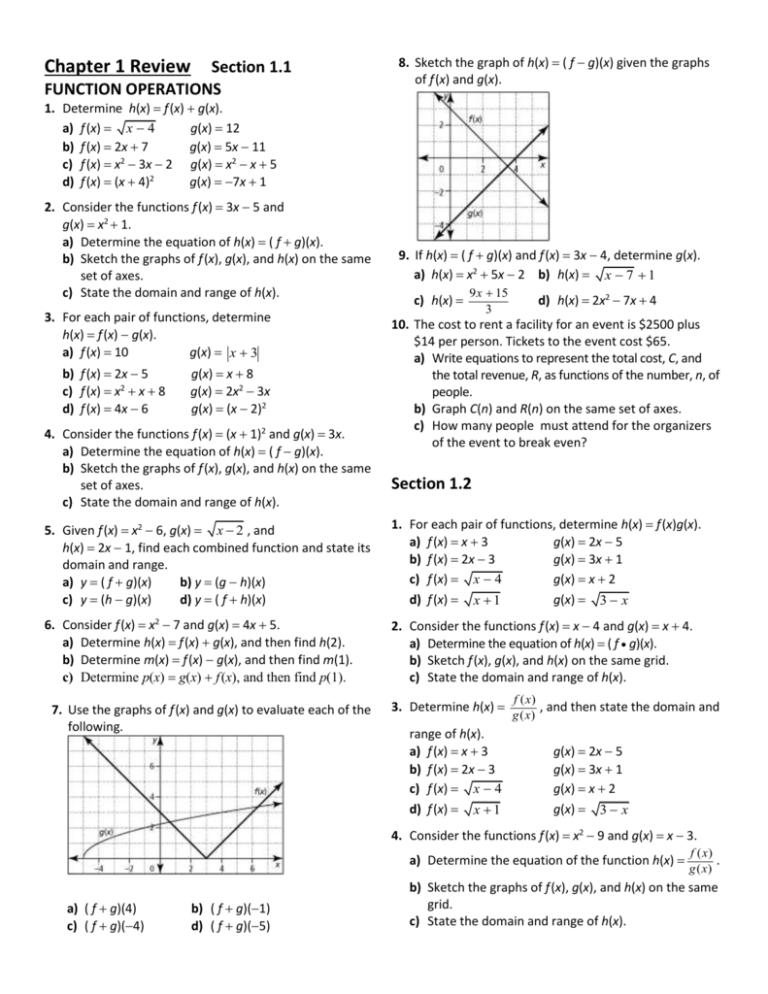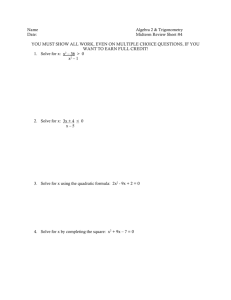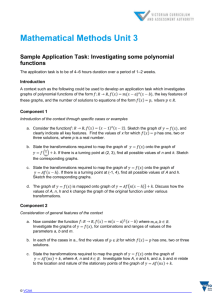Chp 1 Function Operations Review
advertisement

Chapter 1 Review
Section 1.1
FUNCTION OPERATIONS
8. Sketch the graph of h(x) ( f g)(x) given the graphs
of f (x) and g(x).
1. Determine h(x) f (x) g(x).
a) f (x) x 4
g(x) 12
b) f (x) 2x 7
g(x) 5x 11
c) f (x) x2 3x 2 g(x) x2 x 5
d) f (x) (x 4)2
g(x) 7x 1
2. Consider the functions f (x) 3x 5 and
g(x) x2 1.
a) Determine the equation of h(x) ( f g)(x).
b) Sketch the graphs of f (x), g(x), and h(x) on the same
set of axes.
c) State the domain and range of h(x).
3. For each pair of functions, determine
h(x) f (x) g(x).
a) f (x) 10
g(x) x 3
b) f (x) 2x 5
c) f (x) x2 x 8
d) f (x) 4x 6
g(x) x 8
g(x) 2x2 3x
g(x) (x 2)2
4. Consider the functions f (x) (x 1)2 and g(x) 3x.
a) Determine the equation of h(x) ( f g)(x).
b) Sketch the graphs of f (x), g(x), and h(x) on the same
set of axes.
c) State the domain and range of h(x).
9. If h(x) ( f g)(x) and f (x) 3x 4, determine g(x).
a) h(x) x2 5x 2 b) h(x) x 7 1
c) h(x)
9 x 15
3
d) h(x) 2x2 7x 4
10. The cost to rent a facility for an event is $2500 plus
$14 per person. Tickets to the event cost $65.
a) Write equations to represent the total cost, C, and
the total revenue, R, as functions of the number, n, of
people.
b) Graph C(n) and R(n) on the same set of axes.
c) How many people must attend for the organizers
of the event to break even?
Section 1.2
5. Given f (x) x2 6, g(x) x 2 , and
h(x) 2x 1, find each combined function and state its
domain and range.
a) y ( f g)(x)
b) y (g h)(x)
c) y (h g)(x)
d) y ( f h)(x)
1. For each pair of functions, determine h(x) f (x)g(x).
a) f (x) x 3
g(x) 2x 5
b) f (x) 2x 3
g(x) 3x 1
c) f (x) x 4
g(x) x 2
d) f (x) x 1
g(x) 3 x
6. Consider f (x) x2 7 and g(x) 4x 5.
a) Determine h(x) f (x) g(x), and then find h(2).
b) Determine m(x) f (x) g(x), and then find m(1).
c) Determine p(x) g(x) f (x), and then find p(1).
2. Consider the functions f (x) x 4 and g(x) x 4.
a) Determine the equation of h(x) ( f g)(x).
b) Sketch f (x), g(x), and h(x) on the same grid.
c) State the domain and range of h(x).
7. Use the graphs of f (x) and g(x) to evaluate each of the
following.
3. Determine h(x)
range of h(x).
a) f (x) x 3
b) f (x) 2x 3
c) f (x) x 4
d) f (x) x 1
f ( x)
, and then state the domain and
g ( x)
g(x) 2x 5
g(x) 3x 1
g(x) x 2
g(x)
3 x
4. Consider the functions f (x) x2 9 and g(x) x 3.
a) Determine the equation of the function h(x)
a) ( f g)(4)
c) ( f g)(4)
b) ( f g)(1)
d) ( f g)(5)
f ( x)
.
g ( x)
b) Sketch the graphs of f (x), g(x), and h(x) on the same
grid.
c) State the domain and range of h(x).
5. Given f (x) x 1, g(x) 2x 1, and
h(x) 2x2 7x 3, determine each combined function
and state its domain and range.
a) y ( f g)(x)
b) y ( f h)(x)
c) y
g ( x)
f ( x)
d) y
h( x)
g ( x)
6. For each pair of functions f (x) and g(x),
– determine h(x) ( f g)(x)
– sketch f (x), g(x), and h(x) on the same grid
– state the domain and range of h(x)
a) f (x) x2 4x 3
g(x) x 5
b) f (x) x 4
g(x) x2 16
c) f (x)
1
x3
g(x)
1
x 1
Section 1.3
1. Given f (x) 3x 5 and g(x) 2x 7, find each value.
a) f (g(1)) b) f (g(4)) c) g( f (2)) d) g( f (3))
2. Given f (x) 8 2x and g(x) x2 3x 4, find each
value.
a) f (g(1)) b) f (g(4)) c) g( f (2)) d) g( f (3))
3. Given f (1) 7, f (7) 5, f (3) 0, g(1) 3, g(7) 1,
and g(5) 2, find each value.
a) f (g(7)) b) f (g(1)) c) g( f (1)) d) g( f (7))
4. Use the graph to find each value.
7. Use the graphs of f (x) x2 5 and g(x) 2x 1 to
determine each value.
a) g( f (1))
a) ( f g)(1)
f
b) ( f g)(2 c) (1)
g
f
g
g
d) (3)
e) (0) f) (2)
g
f
f
8. For each pair of functions f (x) and g(x),
– determine h(x)
f ( x)
g ( x)
– sketch f (x), g(x), and h(x) on the same grid
– state the domain and range of h(x)
a) f (x) x2 6x 8
g(x) x 4
1
1
g(x)
x2
x6
f ( x)
9. If h(x)
and f (x) x3 6x2 11x 6, determine
g ( x)
b) f (x)
g(x).
a) h(x) x2 3x 2
b) h(x) x2 4x 3
10. Given f (x) x 1, g(x) x 5, and h(x) x 4, determine
each combined function.
a) y f (x)g(x)h(x)
f ( x) g ( x)
c) y
h( x )
b) y
f ( x) g ( x)
h( x )
b) g( f (2))
c) f (g(1))
d) f (g(2))
5. If f (x) 2x 9 and g(x) x2 6, determine each of the
following.
a) f (g(a))
b) g( f (a))
c) f (g(x))
d) g( f (x))
e) f (f (x))
f) g(g(x))
2
6. Consider f (x) x 5 and g(x) x 2.
a) Determine y f (g(x)).
b) Sketch the graph of y f (g(x)).
c) State the domain and range of y f (g(x)).
7. Given f (x) x 2 and g(x) x 5, sketch the graph
of each composite function. Then, determine the
domain and range of each composite function.
a) f (g(x))
b) g(f (x))
8. For each pair of functions, f (x) and g(x), determine
f (g(x)) and g(f (x)).
a) f (x) 3x 1
g(x) x2 2
2
b) f (x) x 4
g(x) 5x 7
2
c) f (x) x x
g(x) x2 x
d) f (x) x2 9
g(x) x 4
9. If h(x) ( f g)(x), determine g(x).
a) h(x) x 4 and f (x) x2
b) h(x) x2 6x 5 and f (x) x2 4
10. A manufacturer’s weekly production of office chairs
can be modelled by the function N(t) 100 25t,
where t is the time in years since 2001, and N is the
number of chairs. The size of the manufacturer’s
workforce can be modelled by the composite function
W(N) 3 N .
a) Write an equation that represents the size of the
workforce as a function of time.
b) Determine the domain and range of the function
from part a).
c) What was the size of the workforce in 2011? How
many office chairs were manufactured in that
year?
8.
Answers Section 1.1
Section 1.2
1. a) h(x) x 4 12 b) h(x) 7x 4 c) h(x) 2x2 4x 3
d) h(x) x2 x 17
2. a) h(x) x2 3x 4
b)
c) domain: {x | x R};
range: {y | y 6.25, R}
1. a) h(x) 2x2 x 15
b) h(x) 6x2 7x 3
c) h(x) x x 4 2 x 4
d) h(x)
9. a) g(x) x2 2x 2
b) g(x) x 7 3x 5
c) g(x) 9 d) g(x) 2x2 10x 8
10. a) C(n) 2500 14n
R(n) 65n
b)
c) 50 people
x 1
3 x
2. a) h(x) x 16
b)
2
3. a) h(x) 10 x 3
b) h(x) x 13
c) h(x) x2 4x 8
d) h(x) x2 8x 10
c) domain: {x | x R}; range: {y | y 16, y R}
4. a) h(x) x2 x 1
b)
3. a) h(x)
c) domain: {x | x R};
range: {y | y 0.75, y R}
range: {y | y ≠
5. a) y = x2
b) h(x)
x 2 6;
domain: {x | x 2, x R};
range: {y | y 2, y R}
b) y =
x3
; domain:
2x 5
x 2 2x 1; domain: {x | x 2, x R};
7
8
range: {y | y 2 , y R} Note: The actual range is difficult to
determine from the graph, and the best estimate for range may
be {y | y 3, y R}.
c) y = 2x x 2 1; domain: {x | x 2, x R};
7
range: {y | 2 y, y R} Note: The actual range is difficult to
8
determine from the graph, and the best estimate for range may
be {y | 3 y, y R}
d) y = x2 2x 7; domain: {x | x R}; range: {y | y 8, y R}
6. a) h(x) x2 4x 2; 10 b) m(x) x2 4x 12; 15
c) p(x) x2 4x 2; 3
7. a) 4 b) 6 c) 8 d) 8
c) h(x)
1
, y R}
2
2x 3
; domain:
3x 1
range: {y | y ≠
1
x x , x R ;
3
2
, y R}
3
x4
; domain: {x | x 4, x R};
x2
range: {y | 0 y
d) h(x)
5
x x , x R ;
2
x 1
3 x
6
, y R}
12
; domain: {x| 1 ≤ x < 3, x R};
range: {y | 0 y, y R}
b)
4. a) h(x) x 3, x 3
c) domain: {x | x ≠ 3, x R};
range: {y | y ≠ 6, y R}
5. a) y 2x2 3x 1; domain: {x | x R};
range: {y | y 0.125, y R}
b) y 2x3 9x2 10x 3;
domain: {x | x R}; range: {y | y R}
c) y
2x 1
; domain: {x | x ≠ 1, x R};
x 1
range: {y | y ≠ 2, y R}
1
2
d) y x 3; domain: {x | x ≠ , x R};
domain: {x | x ≠ 2, 6, x R}; range: {y | y ≠ 2, 1, or 6, y R}
9. a) g(x) x 3 b) g(x) x 2 10. a) y x3 8x2 11x 20
range: {y | y ≠ 2.5, y R}
6. a) h(x) x3 x2 17x 15
2
b) y
x 4x 5
x4
c) y
2x 4
x4
Section 1.3
1. a) 10 b) 40 c) 29 d) 1 2. a) 8 b) 8 c) 184 d) 14
3. a) 7 b) 0 c) 1 d) 2
4. a) 4 b) 6 c) 5 d) 3
5. a) y = 2a2 3 b) y = 4a2 36a 87 c) y = 2x2 3
d) y = 4x2 36x 87 e) y = 4x 27 f) y = x4 12x2 42
6. a) y x 3
b)
domain: {x | x R}; range: {y | y R}
b) h(x) x3 4x2 16x 64
c) domain: {x | x 2, x R}; range: {y | y 5, y R}
7. a)
domain: {x | x 7, x R}; range: {y | y 0, y R}
b)
domain: {x | x R}; range: {y | y R}
c) h(x)
1
x2 2 x 3
domain: {x | x ≠ 1, 3, x R};
1
4
range: {y | y > 0 or y , y R}
7. a) 12 b) 3 c) 4 d) 0.8 e)
0.2 f) 5
8. a) h(x) x 2
domain: {x | x ≠ 4, x R}; range:
{y | y ≠ 2, y R}
domain: {x | x 2, x R}; range: {y | y 5, y R}
8. a) f (g(x)) 3x2 5; g(f (x)) 9x2 6x 3
b) f (g(x)) 25x2 70x 45; g(f (x)) 5x2 13
c) f (g(x)) x4 2x3 x2 x; g(f (x)) x4 2x3 x2 x
2
d) f (g(x)) x 5; g(f (x)) x 5
x6
b) h(x)
x2
9. a) g(x)
x 4 b) g(x) x 3
10. a) W(N(t)) 3 100 25t b) domain: {t | t 0, t R};
range: {W | W 30, W R} c) 57 workers; 350 chairs








